Cite this document
(Three Interviews in the Clinical Practice Area Assignment, n.d.)
Three Interviews in the Clinical Practice Area Assignment. Retrieved from https://studentshare.org/nursing/1508000-mental-health-nursing
Three Interviews in the Clinical Practice Area Assignment. Retrieved from https://studentshare.org/nursing/1508000-mental-health-nursing
(Three Interviews in the Clinical Practice Area Assignment)
Three Interviews in the Clinical Practice Area Assignment. https://studentshare.org/nursing/1508000-mental-health-nursing.
Three Interviews in the Clinical Practice Area Assignment. https://studentshare.org/nursing/1508000-mental-health-nursing.
“Three Interviews in the Clinical Practice Area Assignment”. https://studentshare.org/nursing/1508000-mental-health-nursing.


